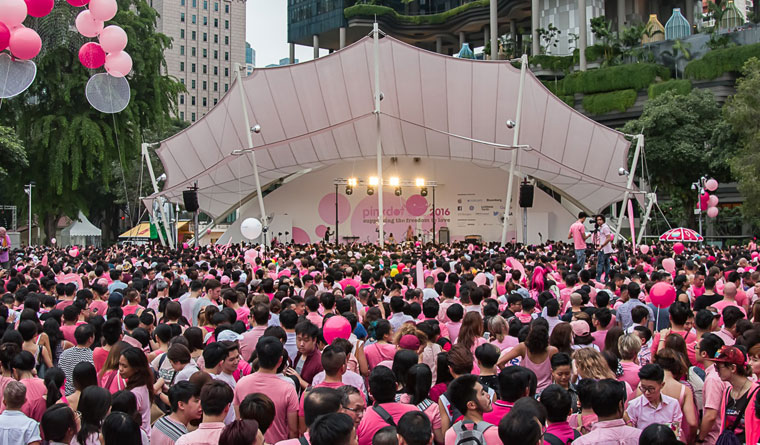This year, Pink Dot, the master of the Singaporean mass movement, changed its direction as they switched over to a day event and focused instead on the people that mattered -- the Everyday Heroes.
Those were not the only changes they made though.
The annual feel-good social movement declined to give an estimate of this year’s crowd size, citing its shift toward community involvement. Organisers, however, said that they handed out all 5,000 of its round placards, which only citizens and permanent residents can collect.
An aerial shot was not released as well -- a departure from a practice for the past seven editions.
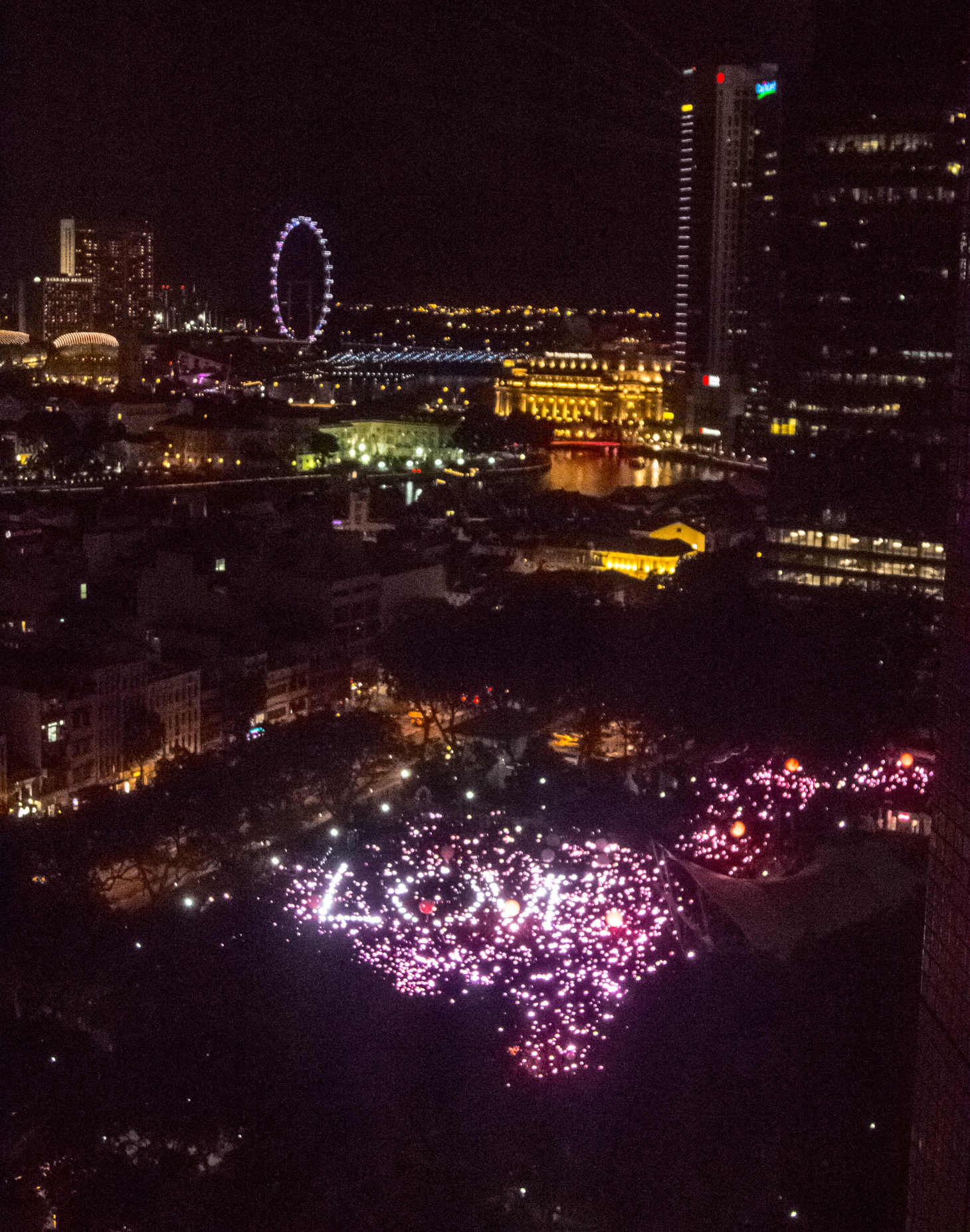 Pink Dot 2015
Pink Dot 2015
But being on the ground, we observed that the overcast skies and occasional drizzle did not seem to dwindle the size or dampen the (extremely cheerful) mood of the crowd.
So in terms of attracting Singaporeans to come down to Hong Lim Park to rally for the freedom to love, Pink Dot has succeeded again.
However, many (except the employees of the sponsors who made up ⅕ of the crowd) who we talked to told us that it was not the first time that they were there.
This is not surprising because we cannot help but get a sense that the narrative of Pink Dot might have just reached a point of diminishing return, in terms of attracting newcomers, as it is repeated year after year.
The sunshine, placards and speeches by their everyday heroes were refreshing, but more has to be done to attract Singaporeans who are still sitting on the fence.
Here’s a list of what Pink Dot has to do differently in order to give these people the little push that they need.
1. Pink Dot has to grow beyond the Hong Lim Park grounds.
It is plain to anyone who was there that Hong Lim Park was not big enough to accommodate the crowd.
This was one of the reasons why the organisers chose not to focus on the numbers anymore, acknowledging that the park has already "exceeded its capacity".
This is not their fault.
It’s no secret that Hong Lim Park is the only place where Singaporeans can hold anything even marginally political. This physical constraint essentially limits their growth to a very large extent, considering Hong Lim Park is only a 0.94 hectare limited space.
The application to hold the event elsewhere would require various licenses from the police and the Media Development Authority. Considering how sensitive their message is, that is an insurmountable task.
Despite the odds, they tried to move Pink Dot outside of Hong Lim Park. Previously, in 2013, organisers applied to either shift Pink Dot to the Promontory@Marina Bay, or close North Canal Road but the police denied them permission.
This year, organisers told Mothership.sg that they did not attempt to apply for alternative locations, unlike in 2013, 2014 and 2015. They cited "format change", where raising placards constitutes a protest and citizens are only legally allowed to protest in Hong Lim Park.
2. Pink Dot needs to refresh its core message
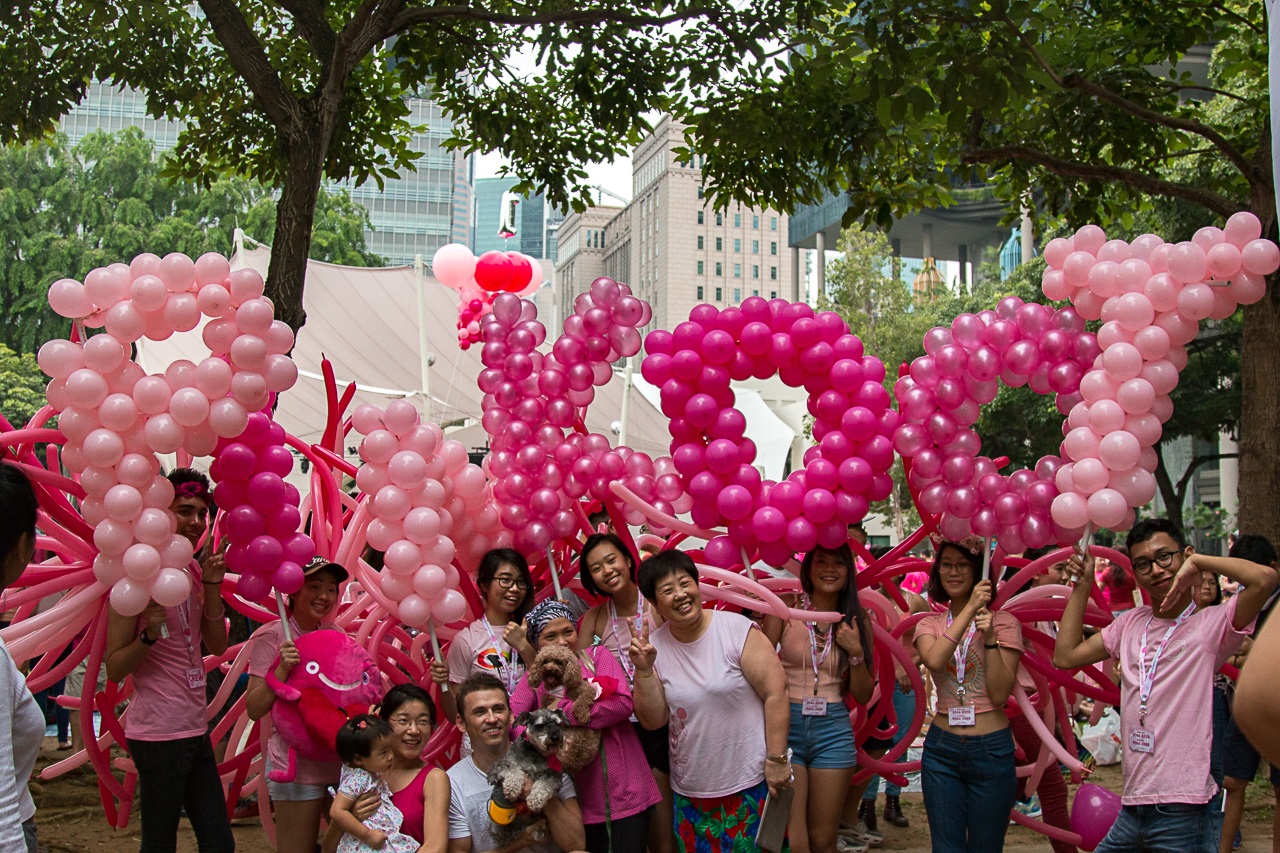 Photo by Ng Yi Shu.
Photo by Ng Yi Shu.
However, the organisers are stuck not just physically. Ideologically, the event remains pretty much the same every year.
Or at least on the surface, picnic mats, potluck and bright smiles, it looks this way to everyone else.
Political change was left out of the docket this year, mainly because there were no opportunities to make this change over the horizon. It was, after all, an uneventful year for the LGBT community: Other than the Adam Lambert New Year countdown controversy, which pitted conservatives against the supporters of LGBT, there was no real controversy or hint at any legislation changes.
Instead, social change was emphasised in both their Community Voices segment and mini-documentaries.
Scrolling through the Pink Dot 2016 photos, the event still looks pretty much similar to previous years. Also, we cannot help but feel that the placards -- the main highlight of this year -- will not look out of place in a protest in Hong Kong.
More disquieting though was that at the Community Tent, the most popular ones were the sponsors’ probably because of the free gifts (a proof to the police that the event was attended by Singaporeans!).
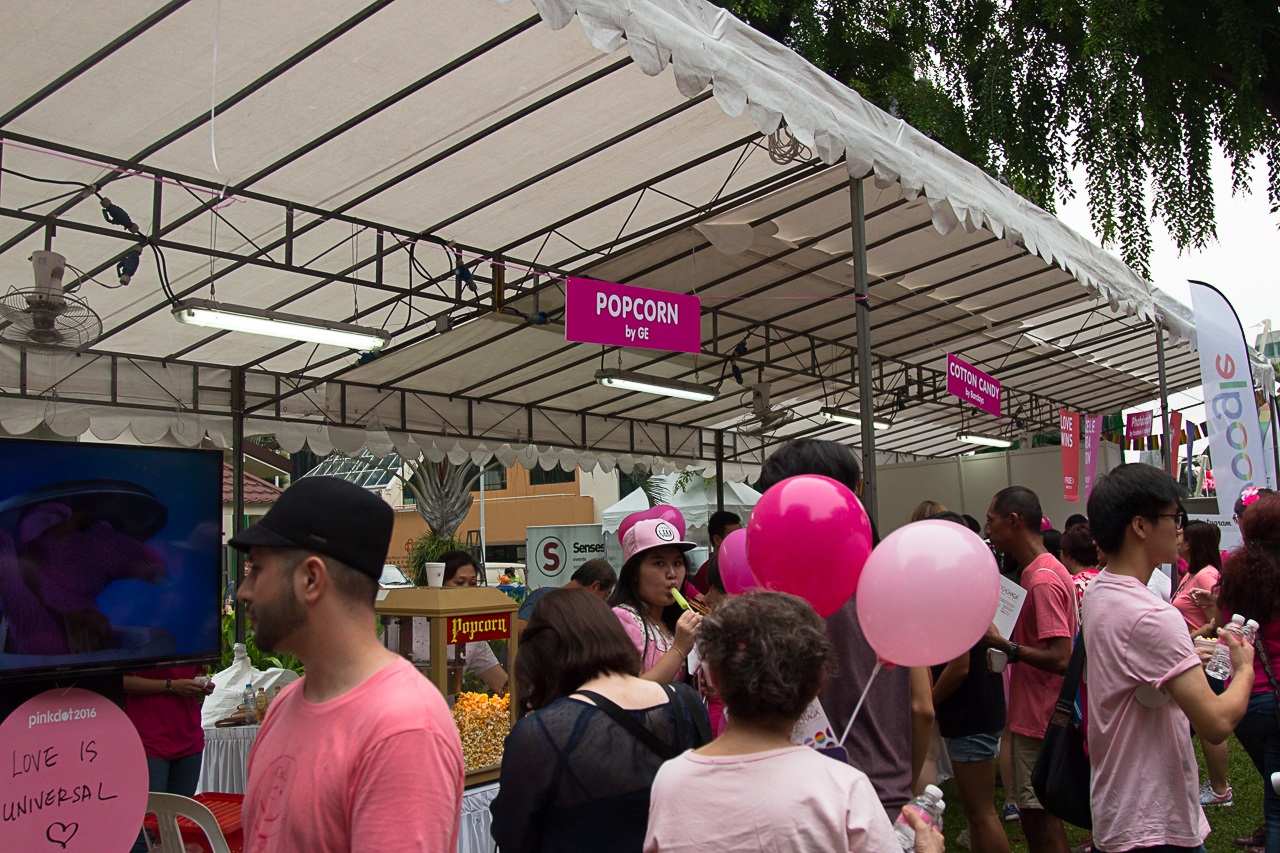 Photo by Ng Yi Shu.
Photo by Ng Yi Shu.
The crowds at the booths that featured the LGBT and LGBT-friendly organisations booths dulled in comparison. This is because many of them were located at the edge of the venue and their set-up were not attention-grabbing enough.
In addition, it was not made immediately obvious what causes they champion for the LGBT community, especially since many have names that are not self-explanatory.
Consider this: What is Oogachaga?
For the uninitiated, they are actually one of the biggest LGBTQ support group in Singapore, specialising in counselling. You would have never guessed that from their name.
Hence, both the Pink Dot organisers and the organisations have to think of ways to attract crowds to their booths educate Singaporeans about their cause.
Moreover, many had to strain to hear the speakers during the Community Voices segment. A quick look around showed most Pink Dot goers being more interested with whatever they are doing than what the speakers had to say.
Maybe next year, organisers should consider increasing the volume or providing subtitles.
3. Pink Dot needs to continue to prove itself as an effective social movement -- by going back to numbers.
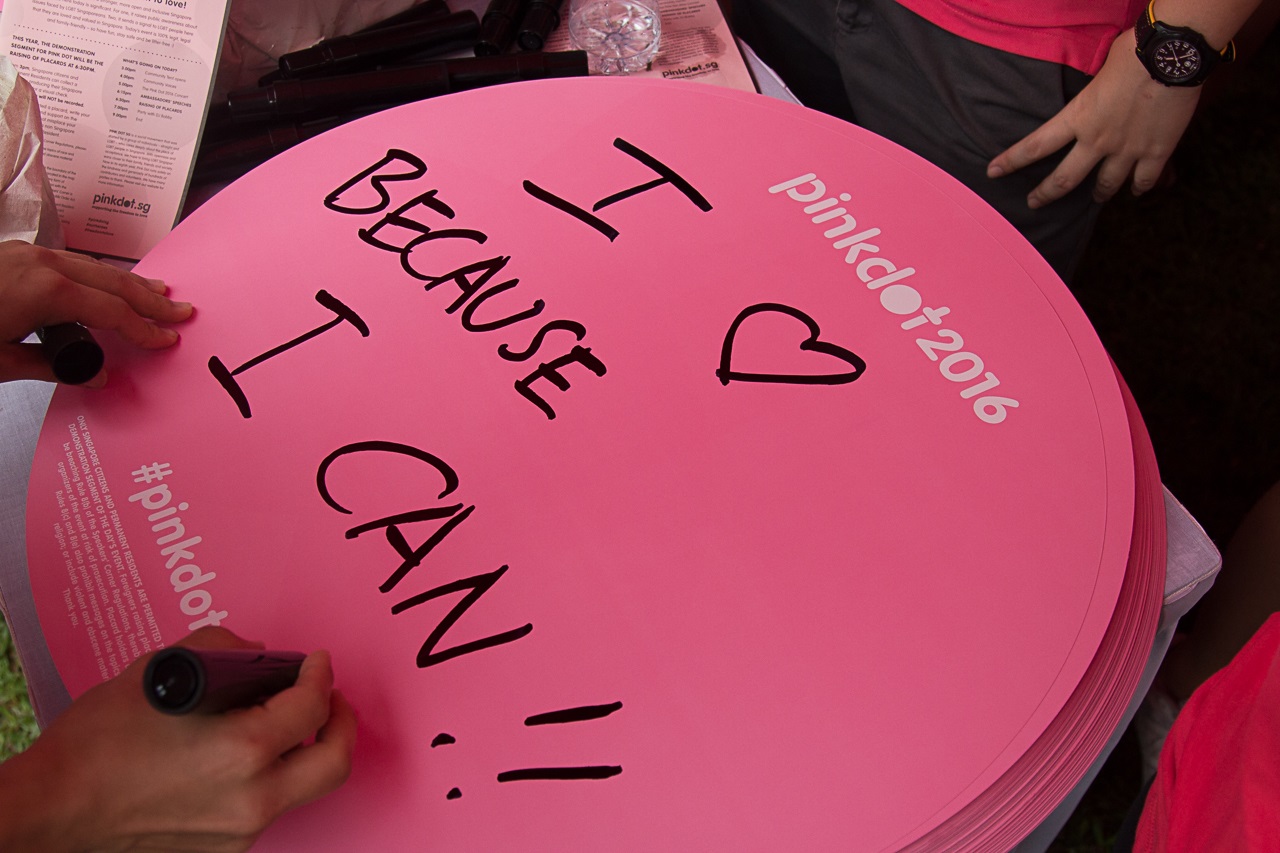 Photo by Ng Yi Shu.
Photo by Ng Yi Shu.
Pink Dot has reached a saturation point. The physical limitations of Hong Lim Park has created a limit -- and this is perhaps why the organisers have moved beyond the numbers.
However, statistics of any kind are scarce in Singapore, but it matters to the average Singaporean. (Just look at how we will not stop using the 70/30 divide of GE2015 when we discuss anything political.) With the lack of public opinion polls -- especially in the topic of homosexuality and acceptance of the LGBT community -- the public is hungry to know how many people have attended Pink Dot.
Of course, the numbers are not reflective of public opinion.
Ask anyone in the Wear White camp, and they’ll tell you that they carry the "moral majority" without the numbers to back that up. It’s impossible to gauge interest through the numbers at Pink Dot too -- there might be people who support them but aren’t able to attend for various reasons.
What Pink Dot can do is to provide new statistics -- releasing the result of opinion polls, measuring the number of citizens who have attended the event, and most importantly, if the number of attendees is no longer noteworthy, then create new headlines by surveying the number of first-timers.
In conclusion...
Nothing can deny the celebratory atmosphere at Pink Dot 2016: Numbers, constraints and opposition aside, Pink Dot remains the largest political gathering at Hong Lim Park.
However, that is not enough because that was never their end game.
Moving forward, in order to convince even more Singaporeans to start wearing pink, Pink Dot must continue to stay relevant and newsworthy (not just for the media but for average Joes to advocate them through word-of-mouth) by breaking boundaries.
It is high-time for them to do something new.
But most importantly, they must educate.
This is because most of the resentment of the LGBT community stems from human nature to fear the unknown. Hence, it cannot be just about star-studded concerts or huge crowds anymore: Pink Dot must shine an even brighter spotlight on our everyday heroes because that is where the most valuable lessons can be learned.
And when majority of Singaporeans are convinced, then we will be able to debate about the issues that the Pink Dot organisers hold dear, such as repealing the 377A and to legalise gay marriage.
It will be a challenge, but let's not forget, Pink Dot started with nothing and look at where they are today.
Photos by Ng Yi Shu.
If you like what you read, follow us on Facebook and Twitter to get the latest updates.
If you like what you read, follow us on Facebook, Instagram, Twitter and Telegram to get the latest updates.
